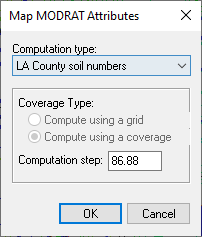WMS:Using GIS Data to Map Parameters
Part of the MODRAT interface in WMS is an automated mapping procedure to define rainfall depth, soil type, percent impervious, and DPA zones from digital data layers. The procedure requires a digital map of the parameter, such as rainfall depth, to be imported into WMS. Digital maps of rainfall depth (isohyetal maps), soil types, land use (percent impervious), and DPA zones are all available from the LACDPW. Once the map is in WMS, functions have been created which will overlay the parameter map on your watershed model and assign the appropriate value to each sub-basin. These functions can be accessed by choosing Map Attributes from the MODRAT menu; the following dialog controls the mapping procedure:
Computation Type
Three parameters may be mapped from this dialog:
LA County soil numbers -- this option will determine the predominate soil type in each sub-basin of the watershed.
LA County land use -- this option will determine the predominate land use type in each sub-basin. The percent impervious is then computed from the land use type.
LA County DPA zones -- this option is currently not in use. The computation will determine which DPA zones exist in a sub-basin, and the area corresponding to these zones.
LA County rainfall depth is mapped using the GIS calculator.
Coverage Type
MODRAT parameters may be mapped from two types of data: gridded (raster) data or coverage (vector) data. These options will be inactivated or activated in accordance with the type of data which exists in WMS.
Computation Step
Mapping attributes in WMS is a grid-based operation; when a parameter is mapped, each basin is broken into an imaginary grid, then each grid cell is assigned the appropriate parameter value. Either an area-weighted average of the parameter value or the predominate value can then be determined.
The computation step value defines the size of each imaginary grid cell. A larger value creates a larger cell size and thus a lower resolution grid. For example, a computation step of 100 will create cells 100 X 100 whereas a step of 50 will create smaller cells (50 X 50). Computation step may need to be adjusted depending on the size of the sub-basins in the watershed. WMS sets the default value in the Computation Step box to a number that will divide the smallest sub-basin in the watershed into a grid 25 cells X 25 cells in resolution. Generally, the default is adequate. If greater accuracy is required, a lower computation step should be used. Note however, a lower computation step will require more computational time.
When gridded attribute data are used (a rainfall depth grid, for example), the computation step will be the same as the grid cell size in the attribute data set and cannot be changed.
Related Topics
| [hide] WMS – Watershed Modeling System | ||
|---|---|---|
| Modules: | Terrain Data • Drainage • Map • Hydrologic Modeling • River • GIS • 2D Grid • 2D Scatter |  |
| Models: | CE-QUAL-W2 • GSSHA • HEC-1 • HEC-HMS • HEC-RAS • HSPF • MODRAT • NSS • OC Hydrograph • OC Rational • Rational • River Tools • Storm Drain • SMPDBK • SWMM • TR-20 • TR-55 | |
| Toolbars: | Modules • Macros • Units • Digitize • Static Tools • Dynamic Tools • Drawing • Get Data Tools | |
| Aquaveo | ||
